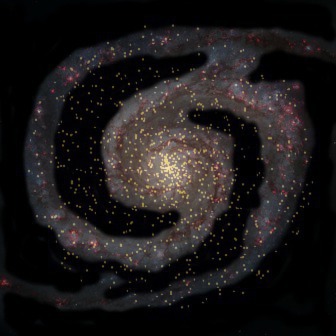Birkeland rotation in galaxy - not dark matter.html
Milky Way current sheet progression indicators, plus: Birkeland currents, NOT dark matter?
Ben Davidson of Suspicious Observers posted 3 brilliant videos on nearby stellar flaring, as further support for a potential "micro-flare" or other solar disruption to explain the 12,000 year [mythological observations, paleontology, geology, planetary] quasi-periodicity of disruptive events on Earth, which by appearances may be "imminent". I like Ben's <=50 to >=200 year uncertainty - and even though that is still a bit of guess, he is meticulous in pointing out the uncertainties.
But can "cyclical" stellar [birth, brighten, dim, death] also provide further potential evidence? Naturally we view stars' life-paths as "unidirectional", but is this a full picture, or can all these processes recur, as is the case for their [sunspots, micro-to-super novas, etc]? What has long fascinated me is the statement that the spirals of the galaxies move more rapidly than the stars in the galaxy, and how that might relate to the [Newtonian, General Relativity] problem at large scales. I first saw mention of this in the paper :
K. Scherer, J. Beer, T. Borrmann, L. Desorgher, E. Fluckiger, H.-J. Fahr, S.E.S. Ferreira, U.W. Langner, M.S. Potgieter, B. Heber, J. Masarik, N. Shaviv, J. Veizer. 2006 "Interstellar-Terrestrial relations: variable cosmic environments, the dynamic heliosphere, and their imprints on terrestrial archives and climate" Kluwer Academic Publishers, Netherlands, 2006 ~163pp -> see Section 6.2 Spiral Arm Passages page25
If I remember correctly, it is thought that this may be the result of "compression waves" moving though the stars. But there may be other explanations.
If we take an "Electric Universe" perspective, in particular Wal Thornhill's Birkeland current concepts for large-scale astronomy, and Don Scott's very interesting "solar transistor" model together with his 2015 Birkeland current model (also 2018 elaboration), then perhaps shifts in the galactic currents could be expected to "reincarnate-light up" or "dim-extinguish" stars to various degrees as the currents shift and move. Many stars (I can't remember all of them - perhaps brown dwarfs, giant planets close to being stars, etc) are not visible by light emission, but perhaps they are easily re-activated when current change. Perhaps in exteme case this might lead to "swapping the central star role" between a large planets and its star in the local z-pinch? In other words, the "lit-up regions" motions may relate more to drifts of galactic currents than to the motions of the stars themselves? In that manner, the "galactic spirals" could move independently of the stars.
My own [cheap, crappy] animation for the spiral currents moving quickly though slowly revolving stars (mpeg format) shows the general idea (click image to view the video, right-click to download) :

Note that the stars don't move properly - that would require more work on the animation. I also haven't checked to see if the illumination has to revolve in the same direction as the stars.
From the perspective of the Milky Way current sheets, are there long-term historical records of local stellar regions [brighten,darken]ing within the range of "parallax" (distance estimates based on the varying Earth position as it revolves around the Sun), which can show indications of an approaching current sheet? While it may be next to impossible to single out stars in distant galaxies to see this, is there enough data on changes to stellar brightness to detect this locally in the Milky Way? As a side comment to explain my emphasis on parallax, I don't trust red shift, as even though it may be a [simple, handy] means of guessing [location, radial speed relative to Earth], and though is is a near-religion in astronomy, Halton Arp proved that it doesn't work in many cases (perhaps most?) and was was severley punished for pointing this out. Even Hubble cautioned against over-confidence in his Nobel-prize-winning concept.
Note that Donald Scott's own analysis of "stellar velocity profiles" provides yet another explanation of what is observed. So my speculations here are just one of many that have been proposed.
